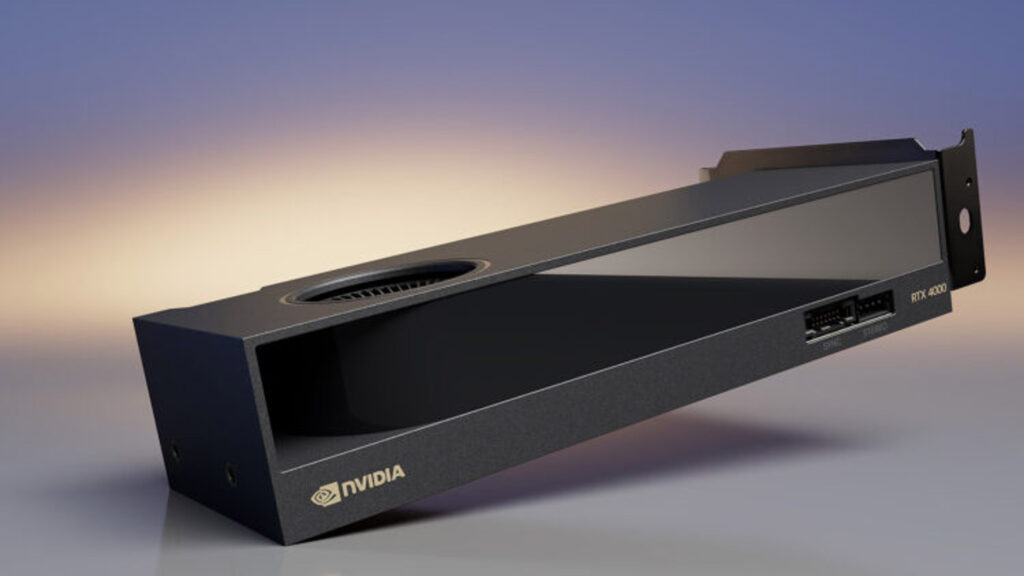Includes full range of GPUs for mobile workstations plus Nvidia RTX 4000 SFF for compact workstations
Nvidia has launched five Nvidia RTX Ada Lovelace GPUs for laptops / mobile workstations and the Nvidia RTX 4000 Small Form Factor (SFF) Ada Generation (20 GB) GPU for compact desktop workstations.
For mobile workstations, the Nvidia RTX 5000 (16 GB), RTX 4000 (12 GB), RTX 3500 (12 GB), RTX 3000 (8 GB) and RTX 2000 (8 GB) Ada Generation laptop GPUs cover all bases from entry-level to high-end, rendering, visualization, and simulation. They are said to deliver twice the performance and power efficiency of the previous generation.
In addition, with Deep Learning Super Sampling 3 (DLSS 3), which uses AI for rendering and viz, Nvidia says it is seeing up to a four times improvement in its Nvidia Omniverse benchmarks.
DLSS 3 uses AI to analyse sequential frames in a scene and then generate additional high-quality frames without having to process the graphics pipeline. The technology works exclusively with Ada generation GPUs.

According to Bob Pette VP/GM, enterprise visualization at Nvidia, Ada is a very power efficient GPU. “We’re on our fifth generation of our Max-Q technology, which allows us to operate lower on the power curve without giving up much performance and so people have the choice of operating at a Max-P (Max power) point on the curve, or the Max-Q point, which allows us to do things like put our ‘3000 class’ graphics into a 35 watt package [for thin and light laptops].”
NVIDIA RTX laptop GPUs will be available starting this month in mobile workstations from global workstation manufacturer partners.
Nvidia RTX 4000 SFF Ada Generation
Nvidia is having a staggered roll out of its Nvidia RTX Ada Lovelace GPUs for desktop workstations. Following on from the ultra-high-end Nvidia RTX 6000 which launched last year, Nvidia has now released a second desktop GPU designed specifically for compact workstations with form factors like those of the HP Z2 SFF, HP Z2 Mini, Lenovo ThinkStation P360 Ultra, Dell Precision 3460 SFF and Dell Precision 3260 Compact. It will likely be of interest to users of CAD or BIM software who want to extend their workflows into visualsation, VR and simulation with tools like Enscape, V-Ray, Twinmotion, Lumion, Omniverse and more.
The Nvidia RTX 4000 SFF Ada Generation features 20 GB of graphics memory, nearly double that of its predecessor, the Nvidia RTX A2000 (12 GB), and is said to offer a 2x performance improvement. It also offers greater memory bandwidth, so it can transfer data to and from its memory more quickly. According to Nvidia, this results in improved graphics, compute and rendering performance.
The Nvidia RTX 4000 SFF is a low-profile, double height graphics card, which takes up two slots on the motherboard. It features a radial type fan for better cooling, where hot air is directly exhausted out of the workstation via the grille on the bracket. It has four mini DisplayPort1.4a connectors.
The GPU is designed to operate with PCIe slot power alone and has a max power consumption of 70W. This is significantly lower than previous generation ‘4000’ class GPUs, which typically draw up to 140W.
However, Nvidia confirmed that, in the future, it will also launch a standard Nvidia RTX 4000 GPU that can take advantage of 140W in a single slot. We expect both GPUs will be share the same silicon, but the Nvidia RTX 4000 SFF will be clocked lower.
Nvidia RTX 4000 SFF specs include 6,144 CUDA parallel processing cores, 192 Nvidia Tensor Cores and 48 Nvidia RT Cores. Nvidia quotes 19.2 TFLOPS single precision performance, 44.3 TFLOPS RT Core performance, and 306.8 TFLOPS Tensor.
This is significantly more than the Nvidia RTX A2000 (8.0 TFLOPs, 15.6 TFLOPS and 63.9 TFLOPS respectively). And while single precision performance and RT core performance is very close to the 140W Nvidia RTX A4000, Tensor performance for AI operations has doubled.
The Nvidia RTX 4000 SFF GPU will be available next month from PNY and other partners at an estimated price of $1,250, and from global workstation manufacturers later this year.






